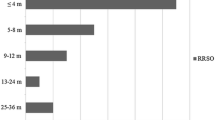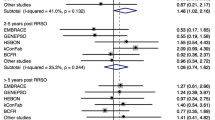Abstract
Introduction Risk-reducing salpingo-oophorectomy (RRSO) reduces the risk of developing ovarian and breast cancer in BRCA 1 and BRCA 2 (BRCA1/2) mutation carriers. The short-term use of hormone replacement therapy (HRT) after RRSO may relieve menopausal symptoms and does not appear to affect the breast cancer risk reduction gained by RRSO. Multiple factors may influence decisions regarding whether or not total abdominal hysterectomy (TAH) is done at the time of RRSO, whether HRT is elected after surgery, and if so, which type of HRT is selected. Our investigation has been to examine factors associated with TAH and HRT use and to determine if the choice of TAH at the time of RRSO and the type of HRT that was chosen has changed since the report of data from the Women’s Health Initiative (WHI) in 2002, which showed that the relative risk for breast cancer is higher in subjects who used combined estrogen–progestin HRT compared with those who used estrogen alone. Methods We identified 73 female BRCA1/2 mutation carriers who were known to have undergone RRSO between 1/1972 and 11/2005 who had no history of breast or ovarian cancer at the time of the surgery. Information regarding whether or not TAH was done in addition to RRSO, the type of HRT, and the subsequent diagnosis of breast cancer was collected. Results Of 73 unaffected BRCA1/2 carriers known to have had RRSO, 40 (40/73, 55%) also underwent TAH. Thirty-three of 73 (33/73, 45%) began HRT following RRSO. Of 33 HRT users, 17 (17/33, 52%) used estrogen only and 14 (14/33, 42%) used combined hormonal therapy. There was no difference in use of HRT in women with TAH (17/40, 43%) vs. those without (16/33, 48%) (P = 0.6). There was no difference in the proportion of women who underwent TAH before and after the WHI report in 2002. Use of HRT, most notably combined estrogen–progestin HRT, appears to have declined since 2002, although this result did not reach statistical significance. Conclusion In this single institution study, the majority of BRCA1/2 mutation carriers undergoing RRSO also underwent TAH, and a substantial number took HRT. TAH did not increase the likelihood of taking HRT compared to RRSO alone.

Similar content being viewed by others
Abbreviations
- RRSO:
-
Risk-reducing salpingo-oophorectomy
- BSO:
-
Bilateral salpingo-oophorectomy
- TAH:
-
Total abdominal hysterectomy
- HRT:
-
Hormone replacement therapy
- PM:
-
Prophylactic mastectomy
- WHI:
-
Women’s health initiative
References
Antoniou AC, Pharoah PD, Narod S et al (2005) Breast and ovarian cancer risks to carriers of the BRCA1 5382insC and 185delAG and BRCA2 6174delT mutations: a combined analysis of 22 population based studies. J Med Genet 42:602–603. doi:10.1136/jmg.2004.024133
Ford D, Easton DF, Bishop DT et al (1994) Risks of cancer in BRCA1-mutation carriers, Breast Cancer Linkage Consortium. Lancet 343:692–695. doi:10.1016/S0140-6736(94)91578-4
Ford D, Easton DF, Stratton M et al (1998) Genetic heterogeneity and penetrance analysis of the BRCA1 and BRCA2 genes in breast cancer families, The Breast Cancer Linkage Consortium. Am J Hum Genet 62:676–689. doi:10.1086/301749
Rebbeck TR, Lynch HT, Neuhausen SL et al (2002) Prophylactic oophorectomy in carriers of BRCA1 or BRCA2 mutations. N Engl J Med 346:1616–1622. doi:10.1056/NEJMoa012158
Kauff ND, Satagopan JM, Robson ME et al (2002) Risk-reducing salpingo-oophorectomy in women with a BRCA1 or BRCA2 mutation. N Engl J Med 346:1609–1615. doi:10.1056/NEJMoa020119
Finch A, Beiner M, Lubinski J et al (2006) Salpingo-oophorectomy and the risk of ovarian, fallopian tube, and peritoneal cancers in women with a BRCA1 or BRCA2 mutation. JAMA 296:185–192. doi:10.1001/jama.296.2.185
Rutter JL, Wacholder S, Chetrit A et al (2003) Gynecologic surgeries and risk of ovarian cancer in women with BRCA1 and BRCA2 Ashkenazi founder mutations: an Israeli population-based case–control study. J Natl Cancer Inst 95:1072–1078
Domchek SM, Friebel TM, Neuhausen SL et al (2006) Mortality after bilateral salpingo-oophorectomy in BRCA1 and BRCA2 mutation carriers: a prospective cohort study. Lancet Oncol 7:223–229. doi:10.1016/S1470-2045(06)70585-X
Rocca WA, Grossardt BR, de Andrade M et al (2006) Survival patterns after oophorectomy in premenopausal women: a population-based cohort study. Lancet Oncol 7:821–828. doi:10.1016/S1470-2045(06)70869-5
Madalinska JB, Hollenstein J, Bleiker E et al (2005) Quality-of-life effects of prophylactic salpingo-oophorectomy versus gynecologic screening among women at increased risk of hereditary ovarian cancer. J Clin Oncol 23:6890–6898. doi:10.1200/JCO.2005.02.626
Madalinska JB, van Beurden M, Bleiker EM et al (2006) The impact of hormone replacement therapy on menopausal symptoms in younger high-risk women after prophylactic salpingo-oophorectomy. J Clin Oncol 24:3576–3582. doi:10.1200/JCO.2005.05.1896
Anderson GL, Limacher M, Assaf AR et al (2004) Effects of conjugated equine estrogen in postmenopausal women with hysterectomy: the women’s health initiative randomized controlled trial. JAMA 291:1701–1712. doi:10.1001/jama.291.14.1701
Rossouw JE, Anderson GL, Prentice RL et al (2002) Risks and benefits of estrogen plus progestin in healthy postmenopausal women: principal results from the women’s health initiative randomized controlled trial. JAMA 288:321–333. doi:10.1001/jama.288.3.321
Rebbeck TR, Friebel T, Wagner T et al (2006) Effect of short-term hormone replacement therapy on breast cancer risk reduction after bilateral prophylactic oophorectomy in BRCA1 and BRCA2 mutation carriers: the PROSE Study Group. J Clin Oncol 23:7804–7810. doi:10.1200/JCO.2004.00.8151
Grady D, Gebretsadik T, Kerlikowske K et al (1995) Hormone replacement therapy and endometrial cancer risk: a meta-analysis. Obstet Gynecol 85:304–313. doi:10.1016/0029-7844(94)00383-O
Leetanaporn R, Tintara H (1996) A comparative study of outcome of laparoscopic salpingo-oophorectomy versus open salpingo-oophorectomy. J Obstet Gynaecol Res 22:79–83
Hidlebaugh DA, Vulgaropulos S, Orr R (1996) Trends in oophorectomy by laparoscopic versus open techniques. J Am Assoc Gynecol Laparosc 3:S17–S18. doi:10.1016/S1074-3804(96)80189-7
Casey M, Garcia-Padial J, Hakert D et al (1998) Changing trends in surgical approaches to hysterectomy: an analysis of the use of laparoscopic assisted vaginal hysterectomies in clinic practice. J Gynecol Surg 14:15–24
Casey M, Bewtra C, Garcia-Padial J et al (1995) Laparoscopic examination and assisted bilateral salpingo-oophorectomy hysterectomy for prophylactic removal of the ovaries and uterus in women at genetic risk for ovarian cancer. J Gynecol Technol 1:111–114
Eltabbakh G, Piver M, Hempling R et al (1999) Laparoscopic management of women with a family history of ovarian cancer. J Surg Oncol 72:9–13. doi :10.1002/(SICI)1096-9098(199909)72:1<9::AID-JSO3>3.0.CO;2-7
Rutqvist LE, Johansson H (2007) Long-term follow-up of the randomized Stockholm trial on adjuvant tamoxifen among postmenopausal patients with early stage breast cancer. Acta Oncol 46:133–145
Brose MS, Rebbeck TR, Calzone KA et al (2002) Cancer risk estimates for BRCA1 mutation carriers identified in a risk evaluation program. J Natl Cancer Inst 94:1365–1372
Gerritzen LH, Grefte JM, Hoogerbrugge N et al (2006) A substantial part of the fallopian tube is left after standard prophylactic bilateral salpingo-oophorectomy. Int J Gynecol Cancer 16:1940–1944. doi:10.1111/j.1525-1438.2006.00720.x
Schmeler KM, Sun CC, Bodurka DC et al (2006) Prophylactic bilateral salpingo-oophorectomy compared with surveillance in women with BRCA mutations. Obstet Gynecol 108:515–520
Acknowledgements
This work was funded by the Marjorie B. Cohen Foundation (to SMD) and the Cancer Genetics Network.
Author information
Authors and Affiliations
Corresponding author
Rights and permissions
About this article
Cite this article
Gabriel, C.A., Tigges-Cardwell, J., Stopfer, J. et al. Use of total abdominal hysterectomy and hormone replacement therapy in BRCA1 and BRCA2 mutation carriers undergoing risk-reducing salpingo-oophorectomy. Familial Cancer 8, 23–28 (2009). https://doi.org/10.1007/s10689-008-9208-6
Received:
Accepted:
Published:
Issue Date:
DOI: https://doi.org/10.1007/s10689-008-9208-6




